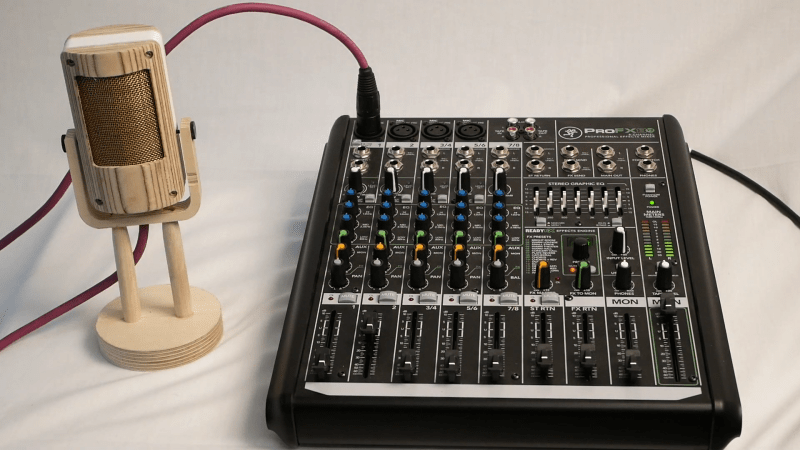We love it when someone takes an idea they’ve seen on Hackaday and runs with it, taking it in a new and different direction. That’s pretty much what we’re here for, after all, and it’s pretty gratifying to see projects like this wooden ribbon microphone come to life.
Now, we’re not completely sure that [Maya Román] was inspired by our coverage of [Frank Olson]’s homage to the RCA Model 44 studio mic rendered in walnut veneer, but we’re going to pat ourselves on the back here anyway. The interesting thing with [Maya]’s build is that she chose completely different materials and design styles for her project. Where [Frank] built as much of his mic from wood as possible, [Maya] was fine with a mixed media approach — CNC-milled plywood for the case and stand, laser-cut acrylic for the ribbon motor frame, and 3D-printed pieces here and there as needed. The woven brass cloth used as a windscreen is a nice detail; while the whole thing looks — and sounds — great, we think it would be even better with a coat of dark stain to contrast against the brass, as well as a nice glossy coat of polyurethane.
The video below shows the whole design and build process, which was a final project for [Maya]’s audio production class this semester at college. Here’s hoping that it got as good a grade as we would give it.
















Bravo Maya! I thought this project was going to be a DIY casing of a kit microphone … which would’ve been awesome regardless. The fact that the whole dang microphone is from scratch is amazing! You have a real talent there! Keep at this kinda thing!
Nice build. Great presentation.
I wonder how well it would perform with a proper yoke to provide the magnetic field return path, like a real ’44. Using acrylic for that looks a bit cargo-cultish. Perhaps it just doesn’t matter, with the whopping field from rare-earth magnets compared to the original.
it does matter…if you complete the mag. field loop, it will resist interference a lot more
“warmth” or as I like to call it: signal distortion, attenuation of some set of frequencies, and possibly resonance in some frequencies.
well done though, I love me some of the tasty kind of distortion.
It does seem that the purpose of the dual wires at the top of the ribbon is routinely misunderstood, and in fact it is misstated in this video. Two return wires in this form do not constitute a shield. Consider:
If you had only one return wire off the top of the ribbon–let’s say to the left–then what you’ve effectively created is a single-turn counter-clockwise loop. This loop will generate an electrical signal in response to any changing magnetic field in its presence. Since the only part of the mike you really want producing electricity is the ribbon itself, the signal created by the return-wire loop manifests as “electrical noise” in the mike’s output… usually 60 Hz hum.
Now let’s run a single return wire off off the top of the ribbon again, but this time to the RIGHT. Well, that creates another single-turn loop, albeit a clockwise loop. The clockwise loop will respond to changing magnetic fields the same way that the other loop did, but with one difference: The phase of the noise signal in the clockwise loop is 180 degrees opposed to the noise signal that would be seen in the counter-clockwise loop.
And therein lies the reason for using two wires…. Because the induced noise signals in the two wires are out of phase with each other, if you use BOTH of them and then tie them together where they meet the transformer, the noise signal in each will cancel the noise signal in the other. This is really a kind of “hum-bucking” arrangement.
Again- The two-wire arrangement is not a “shield” and won’t protect you from noise induced electostatically. Therefore, I think a worthwhile extra step in the fabrication of a mike like this would be to line the interior of the case with adhesive-backed copper foil , and then ground the foil (This is often done in the control/switch pockets in the body of electric guitars.) I would solder a flying lead to the wire mesh grill and ground that, too.
The only other suggestion I would make is one of personal preference. I would dump the rubber bands in the suspension in favor of some synthetic rubber O-rings. Where I live, natural rubber bands dry rot so fast as to be worthless.
In any event, none of my comments above should be construed to detract from what is a very nice project with admirable craftsmanship.
At first glance I thought it just a nice wooden case but was amazed to find you’ve built the whole mic.
Well done, it’s super. I do agree with the need to stain and varnish, as the raw surface will gather fingerprints and dirt from general handling. But that’s a minor addition to this nice piece.
I was wondering the same regarding the wires being a shield, though not critically thinking into much since not a ground plane/wire.
Excellent detail and interesting watching the small milling machine operate and observing the design. I tore down my first free shock, from a set, for the material and was thinking can possibly use the polished rods if true… for a mini-mill.
Neat!